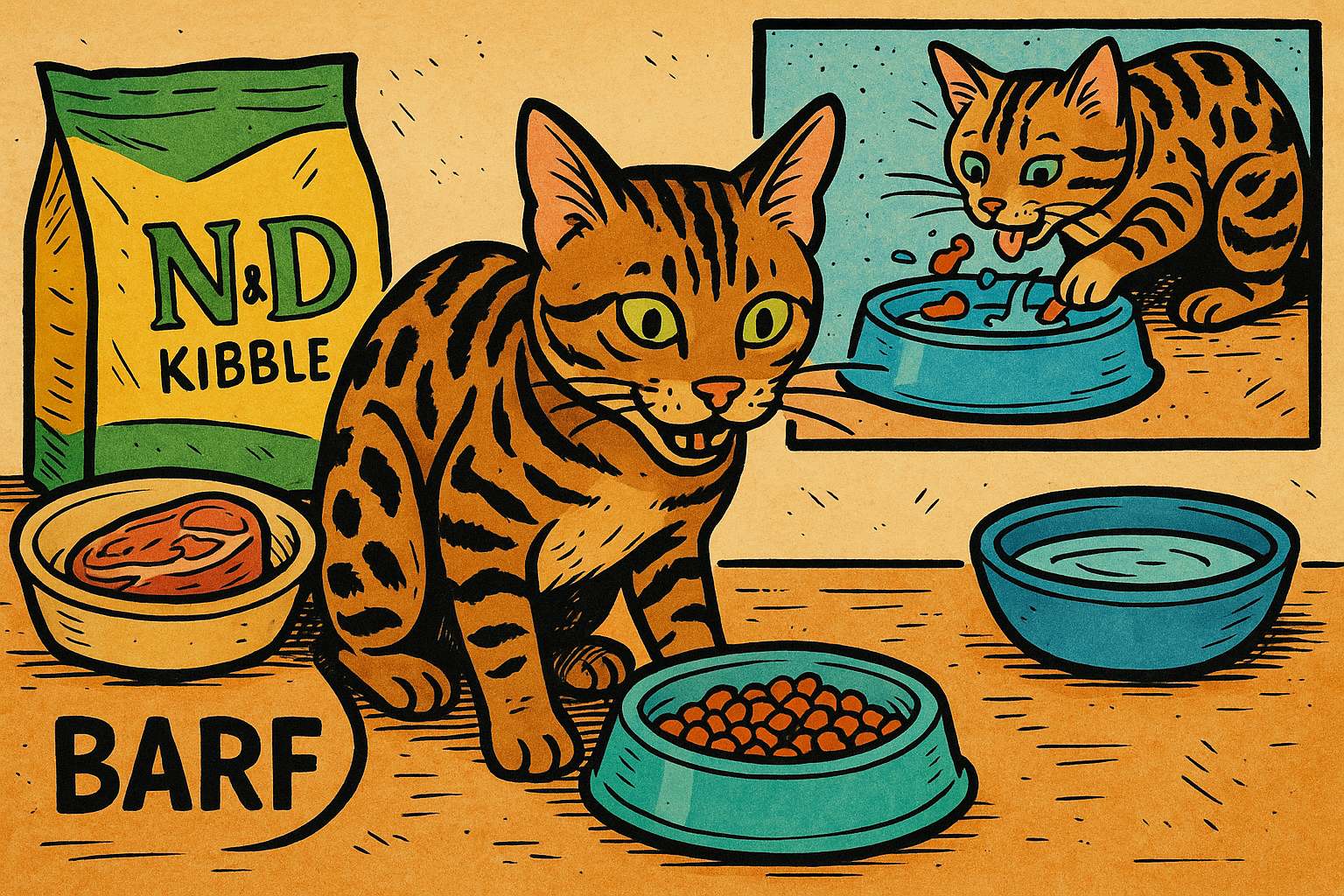How to Feed a Bengal Cat Properly? N&D Kibble, BARF, Hydration Tips & Real-Life Advice from Whinecat.cz
- Hits: 191

What to Feed a Bengal Kitten or Adult Cat? My Experience with N&D Kibble, BARF, and Water Rituals
Bringing home a Bengal kitten means welcoming a bit of wilderness into your life. Those eyes, those legs, that endless energy... And with all that comes a big question: What should I feed this little furry predator to help them grow into a healthy, strong, and happy cat?
At Whinecat.cz, we’ve been fully dedicated to breeding Bengals for years. Over time, we’ve found the balance between a predator's natural nutrition and the practicalities of human life. Let me share what has worked for us—and what I recommend to every new Bengal kitten owner.
A cat is not a small human. It’s a predator—even if it’s sleeping on your pillow right now.
A cat’s digestive system is built for meat: short intestines, specific enzymes, and very limited ability to process carbohydrates. So you can't just choose food based on what we like—your cat needs protein, fat, and taurine. Nothing more, nothing less.
N&D Kibble from Farmina – Why We Use Low Grain (and Not Grain-Free)
In our cattery, we feed our cats N&D kibble from Farmina, especially their low grain formulas. These contain only a small amount of high-quality grains like spelt and oats—no corn, wheat, or soy.
Why low grain?
✅ Because:
- Some grain-free formulas replace grains with large amounts of peas or potatoes, which aren’t ideal
- Spelt and oats have a low glycemic index and are gentle on digestion
- They provide active Bengals with stable energy without sugar spikes
- N&D recipes have a high content of quality animal protein and are preserved with care
And from a breeder’s perspective, kibble is practical—clean, easy to portion, space-efficient, and nutritionally consistent.
BARF – Yes, But Done Right
Raw feeding (BARF) can be a great choice if you want to mimic your cat’s natural diet as closely as possible. It can improve coat shine, muscle tone, and even reduce stool volume.
⚠️ But be careful—meat alone is not complete nutrition. Feeding only chicken breast, for example, will lack calcium, taurine, vitamins A and D, and the correct mineral balance.
✅ A properly balanced BARF should include:
- Meat (ideally a mix of species)
- Bones or calcium supplements (for the Ca:P ratio)
- Organs (liver, heart, kidney)
- Omega-3 (e.g., salmon oil)
- Taurine (especially if not enough is in the heart)
Supplements adjusted for age, activity level, and health status
❗ With kittens, we never feed only meat—bone and tooth development is especially sensitive at this age, and calcium deficiency can cause irreversible damage.
Water – A Necessity, Not a Bonus
Raw meat contains some water, but not enough. Lack of hydration is one of the most common causes of urinary and kidney issues in cats—especially those fed dry food.
💧 How to support your cat’s hydration:
- Have more water bowls than cats in the home
- Never place water next to food—most cats won’t drink there
- Change water daily and wash bowls regularly
- Consider using a cat fountain (more below 👇)
Bengals and Water Fountains: Love at First Bubble
Bengals love water. Not just for drinking—they play with it. They splash it with their paws, toss toys into it, dunk meat in it, and some even use it to wash themselves. In our home, the fountain is the social hub—and the scene of many playful ambushes.
🎉 Why fountains are amazing:
- Flowing water is naturally more appealing (even wild cats prefer a stream to a puddle)
- It stays fresher and more oxygenated
- It encourages cats to drink more—protecting their kidneys and urinary tract
- It doubles as entertainment and mental enrichment
🔁 Tip: Expect to find toys, kibble, or even meat in the fountain. Kittens treat it like a mix of a fishpond and an interactive game.
Where to Place Food and Water Bowls?
You might be surprised—cats don’t like to eat and drink in the same spot. In nature, they wouldn’t drink from a puddle next to a freshly caught mouse either. They need clearly separated zones: food, water, litter box, and rest—ideally each in a different area.
📍 Here’s how we set it up:
- Water is always in a separate room or at least across the room from food
- Food is served in a quiet spot where the cat won’t be disturbed (no dishwasher or dog bed nearby)
- Each cat has its own bowl to avoid stress
- Fountains are placed where cats naturally hang out and have space around them
What We Feed at Whinecat.cz
Our Bengals thrive on a combination of high-quality low grain N&D kibble and raw meat. This ensures both balanced nutrition and flexibility in caring for cats of various ages, conditions, and life stages.
For kittens, we start with finely ground meat, then introduce soaked kibble, and once they can eat on their own, they switch to our usual combo. Every new owner receives a detailed feeding plan, including specific brands and supplement tips.
Final Thoughts
Feeding is more than just a daily task. It’s the foundation of your cat’s health, immunity, longevity, and emotional well-being. Whether you choose kibble, BARF, or a combination, take time to understand your cat’s needs and monitor their condition regularly.
And don’t forget—clean water and a peaceful feeding area are just as important as the food itself.
If you take home a kitten from us, you’ll always receive a personalized feeding guide and support. I’m here for you—and especially for your little wild one.
With love and respect for all cats,
Anita from Whinecat.cz

